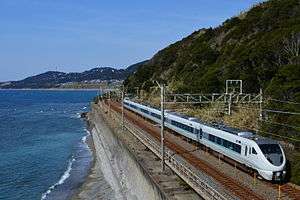Kuroshio (train)
The Kuroshio (くろしお) is a limited express train service in Japan connecting Kyoto, Shin-Osaka, Tennōji, Wakayama, Kii-Tanabe, Shirahama, and Shingu via the Tokaido Main Line (JR Kyoto Line), Osaka Loop Line, Hanwa Line, and Kisei Line (Kinokuni Line), operated by West Japan Railway Company (JR West). This article covers the derivative limited express trains, "Super Kuroshio (スーパーくろしお)" and "Ocean Arrow (オーシャンアロー)", the names of which were discontinued from start of the revised timetable on 17 March 2012.
 A 289 series EMU on a Kuroshio service in February 2016 | |
| Overview | |
|---|---|
| Service type | Limited express |
| Status | Operational |
| First service | 1965 |
| Current operator(s) | JR West |
| Former operator(s) | JNR |
| Route | |
| Line(s) used | Tokaido Main Line (JR Kyoto Line), Osaka Loop Line, Hanwa Line, Kisei Line (Kinokuni Line) |
| Technical | |
| Rolling stock | 283 series, 287 series, 289 series |
| Track gauge | 1,067 mm (3 ft 6 in) |
| Electrification | 1,500 V DC |
Station stops
Kyoto - Shin-Osaka - (Nishikujo) - Tennoji - (Izumi-Fuchu) - (Hineno) - (Izumi-Sunagawa) - Wakayama - Kainan - (Minoshima) - (Fujinami) - (Yuasa) - Gobo - (Minabe) - Kii-Tanabe - Shirahama - Susami - Kushimoto - Koza - Taiji - Kii-Katsuura - Shingu
- (): limited stop
- As trains go direct from the Loop Line to the Umeda Freight Line and Shin-Osaka, no trains go to Osaka Station.
Rolling stock
- 283 series EMUs
- 287 series EMUs
- 289 series EMUs (since 31 October 2015)
New 287 series EMUs were introduced on Kuroshio services from start of the revised timetable on 17 March 2012. From the same date, the Super Kuroshio and Ocean Arrow service names were discontinued, with services integrated with Kuroshio services.[2]
New 289 series EMUs converted from former dual-voltage 683 series trainsets were introduced on Kuroshio services from 31 October 2015, replacing the last remaining JNR-era 381 series trains.[3] The 289 series fleet consists of five six-car sets and three three-car sets (39 vehicles in total).
Former rolling stock
- 381 series EMUs (October 1978 to 30 October 2015)[4]
 A 381 series EMU on a Kuroshio service in September 2011
A 381 series EMU on a Kuroshio service in September 2011
Formations
- Green: Green car (first class)
- White: Standard car (second class)
- O: Observation car
- G (green car), R (standard car): Reserved seats
- NR (standard car only): Non-reserved seats
- No smoking available.
- Direction
- left: Shirahama, Shingū
- right: Shin-Osaka, Kyoto
- The services are sometimes operated as 9-car formation between Kyoto and Shirahama.
| 1 | 2 | 3 | 4 | 5 | 6 |
|---|---|---|---|---|---|
| O, G | NR | NR | R | R | R |
- Women-only seats are available in Car 5.
| 1 | 2 | 3 | 4 | 5 | 6 | |
|---|---|---|---|---|---|---|
| G | R | NR | NR | R | R | R |
- Women-only seats are available in Car 5.
References
- 平成24年春ダイヤ改正について [Spring 2012 Timetable Revision] (PDF) (Press release) (in Japanese). Japan: West Japan Railway Company Wakayama Branch. 16 December 2011. Retrieved 7 January 2012.
- JR西日本 289系 10月31日から運転開始 [JR West 289 series to enter service from 31 October]. Tetsudo Hobidas (in Japanese). Japan: Neko Publishing Co., Ltd. 21 August 2015. Retrieved 21 August 2015.
- くろしお381系引退へ…パンダシートも見納め [Kuroshio 381 series to be withdrawn - Also end of panda seats]. Yomiuri Online (in Japanese). Japan: The Yomiuri Shimbun. 29 October 2015. Retrieved 29 October 2015.
External links
| Wikimedia Commons has media related to Kuroshio (train). |
- JR West 287 series Kuroshio (in Japanese)
- JR West 289 series Kuroshio (in Japanese)
.svg.png)